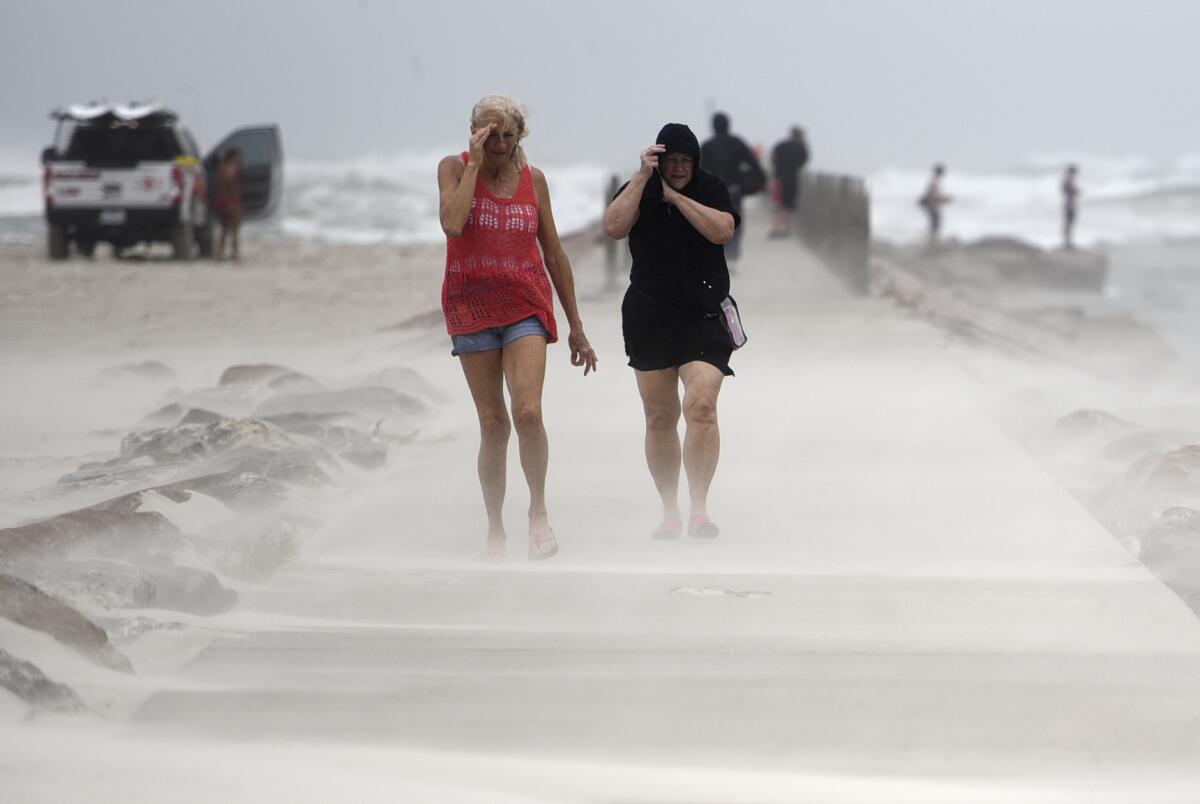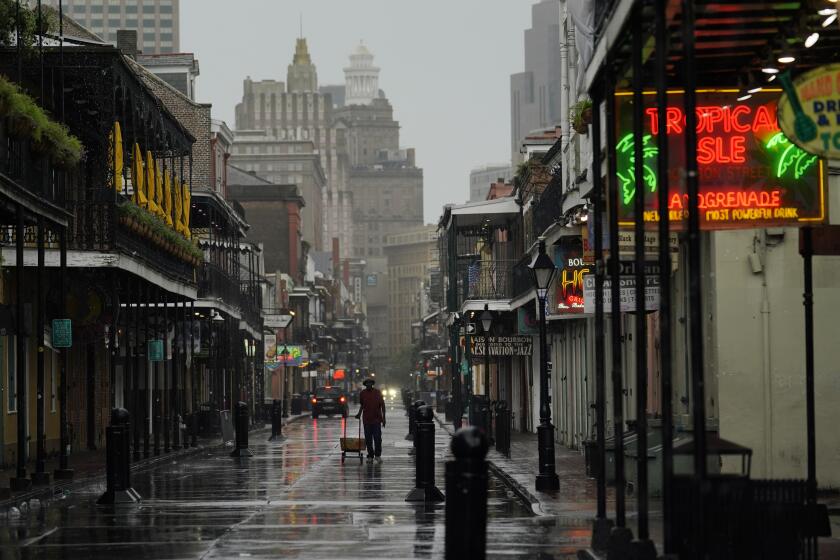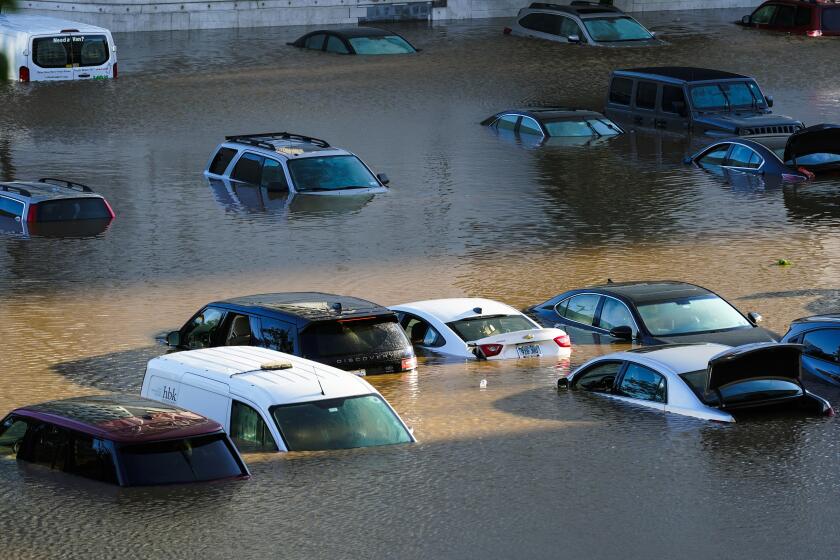Nicholas, now a tropical depression, still douses the Gulf Coast

- Share via
SURFSIDE BEACH, Texas — Tropical Storm Nicholas weakened to a tropical depression early Tuesday evening after slowing to a crawl over southeastern Texas and southwestern Louisiana but still drenching the area with flooding rains.
The downgrade came the same day Nicholas blew ashore as a Category 1 hurricane, knocking out power to half a million homes and businesses and dumping more than a foot of rain along the same area swamped by Hurricane Harvey in 2017.
Nicholas could potentially stall over storm-battered Louisiana and bring life-threatening floods across the Deep South over the coming days, forecasters said.
Nicholas made landfall early Tuesday on the eastern part of the Matagorda Peninsula and was soon downgraded to a tropical storm. As night approached Tuesday, its center was 60 miles east-northeast of Houston, with maximum winds of 35 mph as of 7 p.m. CDT Tuesday, according to the National Hurricane Center in Miami. However, weather radar showed the heaviest rain Tuesday afternoon was over southwestern Louisiana, well east of the storm center.
The storm is moving east-northeast at 6 mph. The National Hurricane Center said the storm may continue to slow and even stall, and although its winds will gradually subside, heavy rainfall and a significant flash flood risk will continue along the Gulf Coast for the next couple of days.
Galveston, Texas, saw nearly 14 inches of rain from Nicholas, the 14th named storm of the 2021 Atlantic hurricane season, while Houston reported more than 6 inches. That’s a fraction of what fell during Harvey, which dumped more than 60 inches of rain in southeast Texas over a four-day period.
In the small coastal town of Surfside Beach about 65 miles south of Houston, Kirk Klaus, 59, and wife Monica Klaus, 62, rode out the storm in their two-bedroom home, which sits about six to eight feet above the ground on stilts.
“It was bad,” Kirk Klaus said. “I won’t ever do it again.”
He said it rained all day Monday, and as the night progressed, the rainfall and winds got worse.
Around 2:30 a.m. Tuesday, the strong winds blew out two of his home’s windows, letting in rain and forcing the couple to continually mop their floors. Kirk Klaus said the rainfall and winds created a storm surge of about 2 feet in front of his home.
“It looked like a river out here,” he said.
A strengthening Hurricane Ida, bearing high winds and the likelihood of flooding rain as it heads for the Louisiana coast, could damage the energy-heavy Gulf Coast economy and potentially have economic consequences well beyond the region.
Nearby, Andrew Connor, 33, of Conroe, Texas, had not been following the news at his family’s rented Surfside Beach vacation house and was unaware of the storm’s approach until it struck. The storm surge surrounded the beach house with water, prompting Connor to consider using surfboards to take his wife and six children to higher ground if the house flooded.
The sea never made its way through the door, but it did flood the family sport utility vehicle, Connor said.
“When I popped the hood, I had seaweed and beach toys and all that stuff in my engine,” he said.
Nicholas is moving so slowly that it will dump several inches of rain as it crawls over Texas and southern Louisiana, meteorologists said. This includes areas already struck by Hurricane Ida and devastated by Hurricane Laura last year. Parts of Louisiana are saturated, with nowhere for the extra water to go, so it will flood, said University of Miami hurricane researcher Brian McNoldy.
“It’s stuck in a weak steering environment,” McNoldy said of Nicholas. So although the storm itself may weaken, “that won’t stop the rain from happening. Whether it’s a tropical storm, tropical depression or post-tropical blob, it’ll still rain a lot, and that’s not really good for that area.”
As a ferocious hurricane bears down on South Florida, water managers desperately lower canals in anticipation of 4 feet of rain.
More than half a million homes and businesses lost power in Texas, but that number had dropped below 200,000 by late Tuesday afternoon, according to the website PowerOutage.us, which tracks utility reports. Most of those outages were caused by powerful winds as the storm moved through overnight, utility officials said. Across Louisiana, about 89,000 customers remained without power Tuesday afternoon, mostly in areas ravaged by Hurricane Ida.
Toward a more sustainable California
Get Boiling Point, our newsletter exploring climate change, energy and the environment, and become part of the conversation — and the solution.
You may occasionally receive promotional content from the Los Angeles Times.
Nicholas brought rain to the same area of Texas that was hit hard by Harvey, which was blamed for at least 68 deaths, including 36 in the Houston area. After Harvey, voters approved the issuance of $2.5 billion in bonds to fund flood-control projects, including the widening of bayous. The 181 projects designed to mitigate damage from future storms are at different stages of completion.
McNoldy, the hurricane researcher, said Nicholas was bringing far less rain than Harvey did.
“It’s not crazy amounts of rain. It isn’t anything like Hurricane Harvey kind of thing with feet of rain,” McNoldy said. Harvey not only stalled for three days over the same area, but it also moved a bit back into the Gulf of Mexico, allowing it to recharge with more water. Nicholas won’t do that, McNoldy said.
The remnants of Hurricane Ida dump record rainfall on the Northeast, causing massive flooding, multiple deaths and major transportation disruptions.
Nicholas could dump up to 20 inches of rain in parts of southern Louisiana. Forecasters said southern Mississippi, southern Alabama and the western Florida Panhandle could see heavy rainfall as well.
On Tuesday, heavy rains from Nicholas pelted blue tarps that covered roofs damaged by Ida all over southern Louisiana.
Ida destroyed one building and left holes in the roof of the main plant at Motivatit Seafoods, a family-run oyster wholesaler in Houma, La. With rain from Nicholas pouring in on high-pressure processing equipment, owner Steven Voisin said he didn’t know whether the machines could be saved after the latest round of tropical weather.
“And many people from here to New Orleans have this or more damage,” he said. “They’re not going to recover quickly or easily.”
Louisiana Gov. John Bel Edwards declared a state of emergency Sunday night, ahead of the storm’s arrival.
In southwestern Louisiana, Lake Charles Mayor Nic Hunter said Monday that crews were scouring the drainage system to keep it free from debris that might clog up and cause flooding. But after multiple natural disasters in such a short period of time, he said he’s worried about residents’ state of mind.
Last year, Category 4 Hurricane Laura caused substantial structural damage across the city of nearly 80,000 residents. Weeks later, Hurricane Delta ripped through the same area. Freezing temperatures in January burst pipes across the city, and a May rainstorm swamped houses and businesses yet again. Some residents have had to gut houses multiple times over one year.
“With what people have gone through over the last 16 months here in Lake Charles, they are very, understandably, despondent, emotional. Any time we have even a hint of a weather event approaching, people get scared,” he said.
Associated Press writers Terry Wallace in Dallas; Jill Bleed in Little Rock, Ark.; Jay Reeves in Houma, La.; Rebecca Santana in New Orleans; Julie Walker in New York, and AP science writer Seth Borenstein in Washington contributed to this report.
More to Read
Sign up for Essential California
The most important California stories and recommendations in your inbox every morning.
You may occasionally receive promotional content from the Los Angeles Times.















